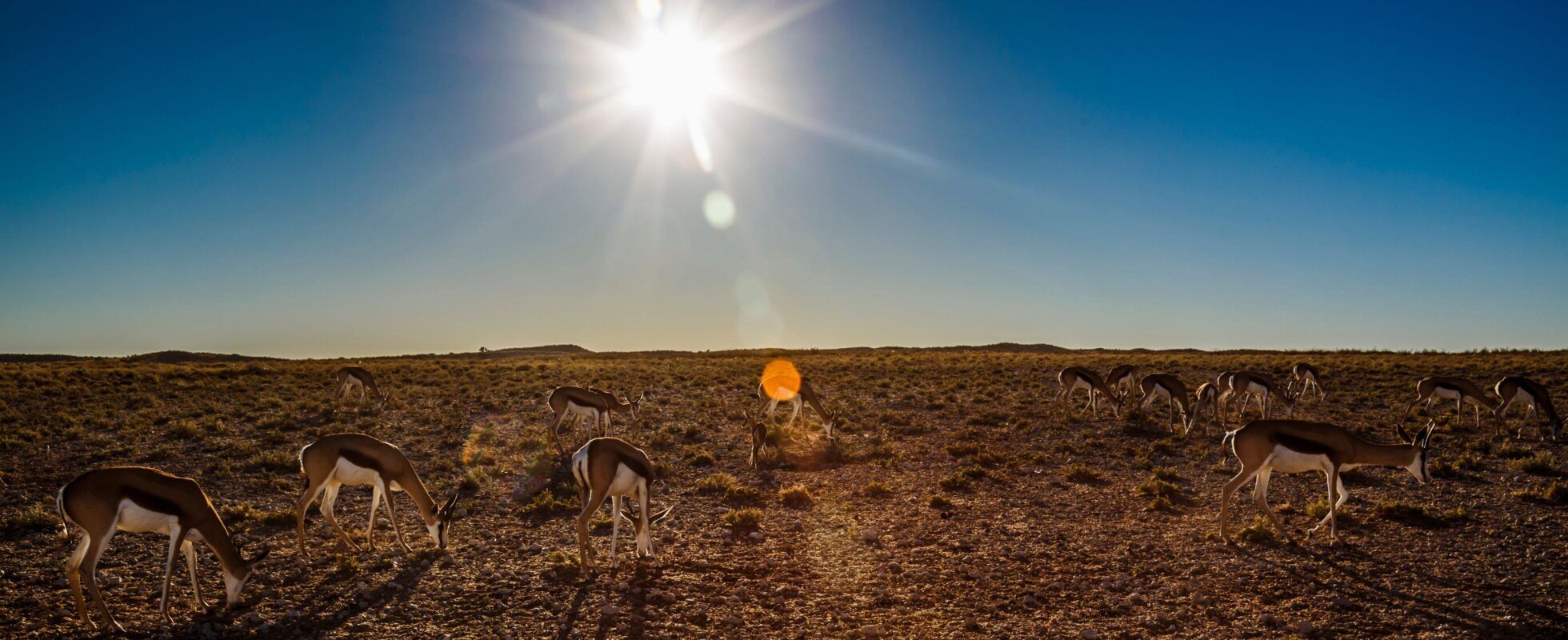
- Activities (unless indicated differently on your itinerary)
- Bed and breakfast (unless indicated differently on your itinerary)

When you think of South Africa, you probably don’t imagine dry desert-like landscapes, right? Well, a part of this country has endless dunes, red-hot sand, chilly nights, and afternoons so hot you could cook an egg on the sand! And where exactly is this?
The Kalahari Desert – home to the epic Kgalagadi Transfrontier Park. Sure, most of it lies in Botswana, but here’s the cool part: the park straddles both countries (South Africa and Botswana), and you can cross the invisible border from the South African side without even noticing. Get ready for miles of sun-soaked sand, herds of antelopes, and (wait for it) lions, cheetahs, and hyenas lurking just around the corner!
Sprawling across a whopping 35,000 square kilometers – yes, that’s bigger than Belgium! – the Kgalagadi Transfrontier Park plunges you into the wild heart of the Kalahari Desert. This massive, sand-filled playground is a land of extremes, with just a few cosy lodges dotted across the vast, untamed landscape. The only roads? Rugged trails made for 4×4 adventurers, especially on the untamed Botswana side. You’ll feel like the last soul on earth, surrounded by nothing but red dunes and a blazing sun. But fear not! That feeling of total isolation won’t last long because our expert drivers have this epic wilderness mapped out like the back of their hands. Buckle up!
Wildlife thrives in this rugged landscape, with predators taking the spotlight. For instance, black-maned lions, hyenas, caracals, cheetahs, and clever jackals roam freely. If you’re really lucky, you might even catch a glimpse of the elusive and endangered African wild dog. Grazing away in this untamed paradise are gemsbok, eland, springbok, and wildebeest, while the more elusive kudu, steenbok, and even giraffes add a touch of magic to the scene. And for the ultimate rare sightings, keep your eyes peeled for a pangolin, a fearless honey badger, or the almost mythical Woosnam’s desert rat.
The scrappy Kalahari bushveld is home to some tough-as-nails survivors like the deep-rooted acacias and funky flora such as the African horned cucumber and the medicinal Hoodia succulent. Despite the scorching heat and dry conditions, life here doesn’t just survive – it thrives!
Once thought to have vanished, the ‡Khomani San and Weir people are the true desert dwellers of the Kalahari. Their ancient roots run so deep that part of the Kgalagadi Transfrontier Park is now a UNESCO World Heritage Site, known as the ‡Khomani San Cultural Landscape. This site showcases the history of human life in the region from the Stone Age to today. These once-nomadic masters of survival know how to thrive in the desert’s harshest conditions. If you stay at the community-run !Xaus Lodge, you’ll have the chance to meet these legendary trackers. Watch as they read the desert like a book, spotting antelope trails, deciphering hyena footprints from the night before, and even telling which way the wind blew and if an animal was injured. It’s like stepping into a living, breathing story of survival!
In Kgalagadi Transfrontier Park, game drives steal the show! Let the trails take you across vast landscapes where all sorts of wildlife are just waiting to be spotted.
By Road: If you’re up for a road trip, the park is about 250 km (about 2.5 hours) from Upington and 904 km (about 10 hours) from Johannesburg. From Johannesburg, you can choose the Upington route, which offers a smoother 255 km tarred road, or go off the beaten path via Kuruman, Hotazel, and Vanzylrus, with a more rugged 340km gravel adventure.
By Air: Prefer flying? Charter flights can be arranged from Cape Town, Johannesburg, Maun, or Upington. But remember to plan ahead as park approval is needed. Alternatively, land at Upington International and enjoy the drive. A flight from Johannesburg (JNB) to Upington (UTN) takes approximately 1.5 to 2 hours.
In this semi-arid region of Kalahari, the climate can be extreme, with scant rainfall. Despite the overall dryness, recent years have seen occasional floods. In the peak of summer (October to April), the heat blazes past 40°C, while winter (May to September) nights plunge below freezing, leaving you to face temperatures as low as -11°C. The park’s recorded extremes range from a sizzling 45°C to icy cold, with rainfall barely making an appearance – just 127mm in the east and up to 350mm in the west. It’s a true land of extremes, where you can experience the desert’s full power.
The best time to visit really depends on what you’re after. From September to November, as the dry season wraps up, animals flock to waterholes, and migratory birds make their grand entrance. January and February bring plenty of action with awesome raptor sightings and dramatic storms, though the temperatures can hit a blazing 45–50°C. If the rains have been kind, March unveils a greener park perfect for birdwatching.
Not a fan of the cold? Skip June and July, when nighttime temperatures can drop to 0 or even -10°C. But don’t worry, the days are still sunny!
Kgalagadi Transfrontier Park stretches across South Africa and Botswana, a vast playground where the Kalahari Desert shows off its wild side! With red dunes, dry riverbeds, and a canvas splashed in gold and crimson, this park is nature’s stage. Prepare for a front-row seat to adventure, where every corner holds a new surprise!


